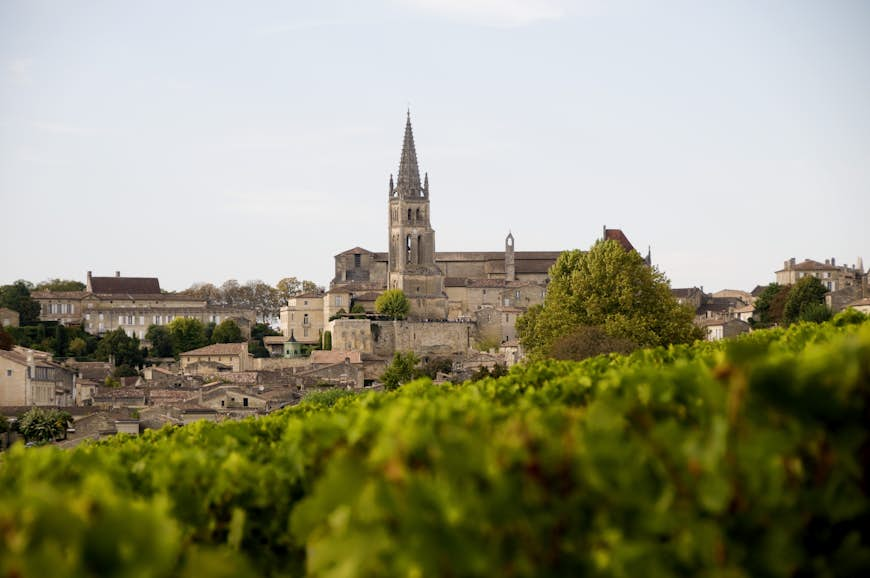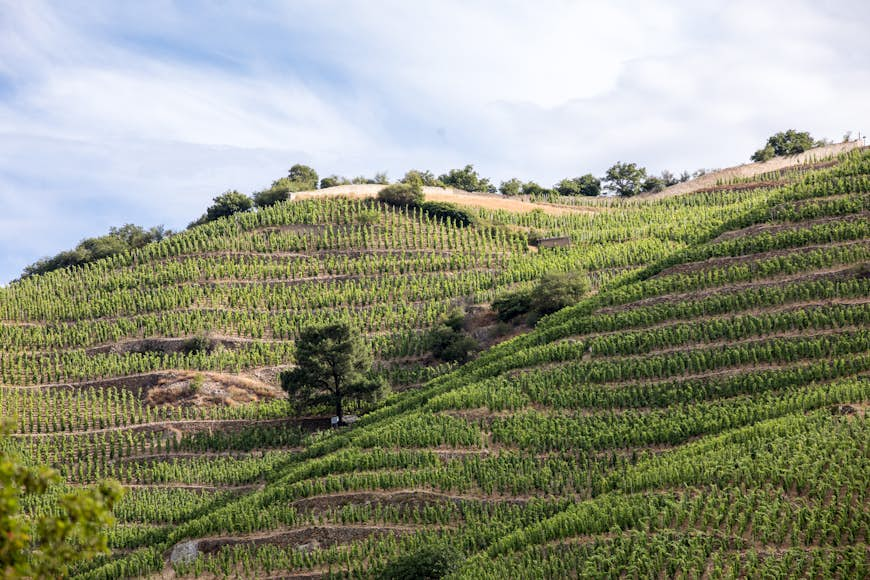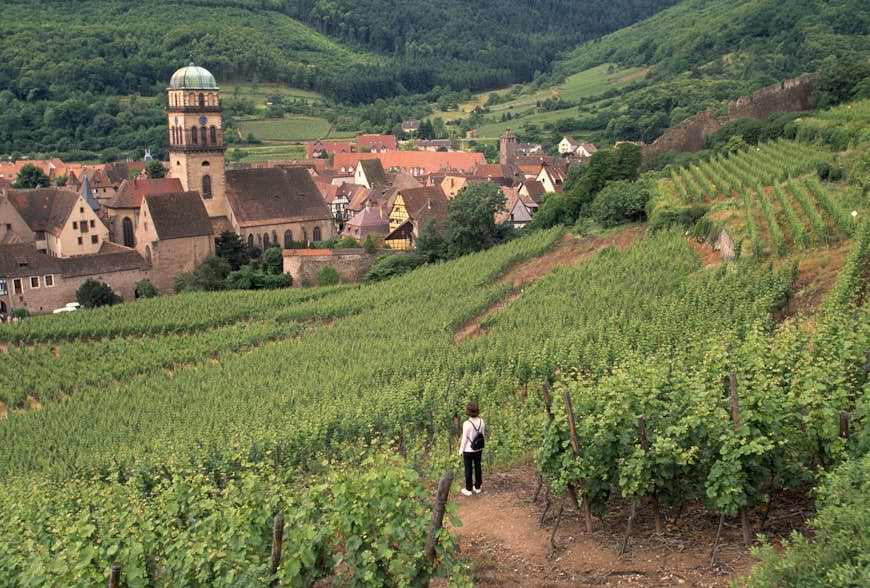
Wine is the lifeblood of France. Since the Romans first cultivated vines here, winemaking has evolved into a fine art.
Today, France is one of the world’s top wine-making countries, producing around 7 to 8 billion bottles each year, and vineyards stretch out across the country.
The secret of France’s celebrated wines is their terroir: the combination of unique characteristics like geology, geography and climate that give wines their distinct properties, brought out by the winemaker.
Place plays such a pivotal role that wines are generally named for the vineyard’s location rather than the grape, and quality wines from a region, sub-region, commune or village designated AOC (Appellation d’Origine Contrôlée; equivalent to the Europe-wide AOP, Appellation d’Origine Protégée) have strict rules around winemaking practices and origin.
Make the most out of every adventure with help from our weekly newsletter delivered to your inbox.
France’s viticultural areas teem with dégustation (tasting) opportunities. Growers and producers usually offer visitors the chance to try before buying, and main centers have details of estates, caves (wine cellars) and cooperatives where you can fill your own container with table wine, along with wine schools and courses.
Here’s a sampler of the best wine regions to visit in France.
Taste terroir in Burgundy
Bucolic Burgundy (Bourgogne in French), southeast of Paris, is distinguished by its climats (defined grape-growing land parcels) that took root during Gallo–Roman days, developed during Charlemagne’s reign when monks made wine here, and now have Unesco World Heritage recognition. Burgundy reds are typically made with pinot noir grapes, with whites made from chardonnay. More than a third of Burgundy’s appellations are top-of-the-hierarchy Grands Crus, aged in oak barrels then bottles for one to two decades.
Along France’s first-ever wine-touring route through the sunlit Côte d’Or (“Golden Hillside”) the Route des Grands Crus takes in renowned châteaux including the “birthplace of Burgundy wines,” Château du Clos de Vougeot, founded in the 12th century by Cistercian monks, and the walled wine town of Beaune, where millions of bottles age in its subterranean cellars.
Burgundy’s important wine-growing areas also include Chablis (synonymous with its crisp whites with flinty minerality), Côte Chalonnaise and Mâcon. Pretty wine-touring Route des Vins Mâconnais-Beaujolais links Mâcon to the south with Beaujolais.
Technically part of Burgundy, Beaujolais is located closer to the Rhône, just outside Lyon, and is often considered as a standalone wine region. Mainly using gamay grapes in fruity, low-tannin reds drunk young, it’s famed for celebrations when the first bottles of Beaujolais nouveau are opened at midnight on the third Thursday each November.
 The medieval village of St-Émilion is one of the most alluring of the Bordeaux region’s wine towns © PatrickHutter / Getty Images
The medieval village of St-Émilion is one of the most alluring of the Bordeaux region’s wine towns © PatrickHutter / Getty Images
Swirl world-famous reds in Bordeaux
Spanning more than 1191 sq km (460 sq miles), Bordeaux is France’s largest wine-growing region, revered for its well-balanced, full-bodied reds blending merlot, cabernet sauvignon and cabernet franc grapes. In the 12th century, they benefited from an export boon when King Henry II granted tax-free trade with England, where they were known as clarets.
In the thriving neoclassical city of Bordeaux, a perfect introduction is La Cité du Vin. Shaped like a giant glinting wine decanter, the wine center has nifty museum exhibits (such as sniffing scents to identify wine aromas), topped off with a tasting at Le Belvédère with panoramic views.
Wine routes run through the surrounding countryside. Northwest, bordered by pine forests and the Gironde estuary, the Médoc is anchored by the port town of Pauillac and counts 60 Grands Crus (all but one of all of the 1855 Classification of Bordeaux reds hail from here).
East of Bordeaux, you’ll find Pomerol and exquisite medieval St-Émilion. Heading south of Bordeaux brings you to Graves, where the first vines were planted in AD 1. Sauternes produces sweet white dessert wines made from sémillon, sauvignon blanc and muscadelle grapes. Bordeaux’s vineyards are easily accessible on day trips from the city, while Pessac-Léognan is closer still, just 4km (2.5 miles) southwest of Bordeaux’s center.
Sip rosé in Provence
Mediterranean Provence received its first vines when the Greeks planted them in Massilia (Marseille) around 600 BC. Bandol reds and Cassis whites are highly prized, but this region of honey-stone villages is most commonly associated with the translucent peach-pink hues of rosé.
Between Nice on the French Riviera seafront and fountain-filled Aix-en-Provence, Côtes de Provence is the largest appellation. Producing three-quarters of the region’s wine, 90% of its output is rosé, made from a blend of red grapes like grenache, syrah, mourvèdre, cinsaut and tibouren (the light color comes from reduced grape-skin contact with the clear juice during fermentation). A chilled glass of dry, delicate, fruity rosé is wonderfully refreshing in the hot southern sun.
 Sample spicy reds and flowery whites in France’s Rhône Valley © wjarek / Getty Images
Sample spicy reds and flowery whites in France’s Rhône Valley © wjarek / Getty Images
Discover the diverse Rhône Valley
Diversity characterizes the vast Rhône Valley and wines of its major AOC, Côtes du Rhône. The north, from Vienne to Valence, has terraced hillsides and a continental climate. Spicy red blends typically incorporate syrah grapes, while blossomy whites are based on viognier grapes.
Traveling south, from Montélimar to Avignon, sees vines interspersed with lavender fields and olive groves. Red blends here are mainly based on grenache grapes, with ripe, red-fruit flavors and fragrance of garrigue (wild-growing scrub). White blends incorporate various grapes and characteristics.
The best-known appellation is Châteauneuf du Pape, so named as the Avignon popes planted its stone-covered vineyards. Beaumes-de-Venise produces a delectably sweet, pale gold fortified wine, Muscat de Beaumes de Venise.
Raise a toast in Champagne
Northeast of Paris, the rolling countryside of Champagne is the only place permitted to use the name (sparkling wines produced elsewhere in France are termed crémant). The region’s eponymous fizz has been a fixture since monk Dom Pierre Pérignon made it here in the 17th century.
Champagne’s creation is painstaking. White chardonnay, red pinot noir or black pinot meunier grapes are carefully cultivated in small quantities. Wine is fermented twice (first in casks and again after it’s been bottled with yeast and sugar added) and aged in cellars for two to five years, with a highly complex process to remove the sediment. When it’s time to pop the cork, Champagne flutes are specially designed to develop bubbles and enhance aromas.
Famous Champagne houses welcome visitors in the city of Reims and elegant town of Épernay, home to the Musée du Vin de Champagne et d’Archéologie Régionale (Museum of Champagne Wine and Regional Archaeology), opened in 2021. Touring routes fanning out into the vines include the Montagne de Reims, Vallée de la Marne and Côte des Blancs.
Savor fine wines in the Loire Valley
Storybook castles and splendid historic towns are hallmarks of France’s Loire Valley along with exceptional wines produced along France’s longest river as it winds from the Muscadet region near the Atlantic coast’s spirited city of Nantes to Sancerre and Pouilly-Fumé close to Orléans.
This extensive area has a greater variety of wines than any French region. Light, delicate whites (mainly from chenin blanc, sauvignon blanc and melon grapes) account for the majority and are some of the country’s finest. The Loire’s crémant production is second only to Champagne. Reds, made from cabernet franc, are notable around Chinon, midway between Angers and the university town of Tours.
 Alsace is the place to taste white wines in France © Atlantinde Phototravel / Getty Images
Alsace is the place to taste white wines in France © Atlantinde Phototravel / Getty Images
Try distinctive whites in Alsace
In eastern France, Alsace is a charmer with vineyard-striped hills, mist-shrouded mountains and half-timbered towns and villages. Its Germanic influence means it’s France’s only AOC to produce mainly varietal wines. Whites predominate here, particularly riesling, gewürztraminer, pinot gris and sweet Muscat d’Alsace. Sparkling Crémant d’Alsace is increasingly popular.
The ultimate way to discover Alsace’s wines is to follow the Route des Vins d’Alsace. Starting outside the vibrant city of Strasbourg and finishing close to medieval Colmar, this enchanting wine route is one of the most scenic drives in France.



